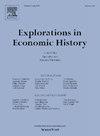Ascending from the bottom rung: The labor market assimilation of rural-urban migrants in Sweden, 1880–1910
IF 1.7
1区 历史学
Q1 ECONOMICS
引用次数: 0
Abstract
This article examines the assimilation of rural-born people into the urban economy in the industrialization context, focusing on Sweden from 1880 to 1910—a time characterized by a notable shift in economic activity towards urban areas. I utilize individual-level data on three cohorts of rural-urban migrants linked across census records, allowing for an examination of their labor market assimilation across all Swedish towns. The main findings suggest that the labor market assimilation of male migrants followed a Chiswick-like process, regardless of the size of the destination area. Initially, migrants displayed a sizeable negative gap in labor market outcomes compared to urban natives, which narrowed with the time spent in the urban area. Nevertheless, they never managed to close the gap over time. By contrast, female migrants displayed few signs of converging with female natives. Migrants’ inability to close the gap was likely due to the non-transferability of skills between the rural and urban sectors. The convergence that did occur can be explained by the potential for upward mobility from the relatively low initial positions migrants entered and, to some extent, negative selection into return migration.
从最底层上升:1880-1910年瑞典城乡移民的劳动力市场同化
本文考察了工业化背景下农村出生的人对城市经济的同化,重点关注1880年至1910年的瑞典,这一时期的特点是经济活动向城市地区显著转移。我利用与人口普查记录相关联的三组城乡移民的个人数据,允许检查他们在瑞典所有城镇的劳动力市场同化情况。主要发现表明,劳动力市场对男性移民的同化遵循了一个类似奇斯威克的过程,与目的地地区的大小无关。最初,与城市本地人相比,移民在劳动力市场结果上显示出相当大的负差距,随着在城市地区的时间延长,这一差距缩小。然而,随着时间的推移,他们从未设法缩小差距。相比之下,女性移民几乎没有表现出与当地女性融合的迹象。移徙者无法缩小差距可能是由于技能在农村和城市部门之间不可转移。确实发生的趋同可以用移民从相对较低的初始位置向上流动的潜力以及在某种程度上对返回移民的负面选择来解释。
本文章由计算机程序翻译,如有差异,请以英文原文为准。
求助全文
约1分钟内获得全文
求助全文
来源期刊

Explorations in Economic History
Multiple-
CiteScore
2.50
自引率
8.70%
发文量
27
期刊介绍:
Explorations in Economic History provides broad coverage of the application of economic analysis to historical episodes. The journal has a tradition of innovative applications of theory and quantitative techniques, and it explores all aspects of economic change, all historical periods, all geographical locations, and all political and social systems. The journal includes papers by economists, economic historians, demographers, geographers, and sociologists. Explorations in Economic History is the only journal where you will find "Essays in Exploration." This unique department alerts economic historians to the potential in a new area of research, surveying the recent literature and then identifying the most promising issues to pursue.
 求助内容:
求助内容: 应助结果提醒方式:
应助结果提醒方式:


